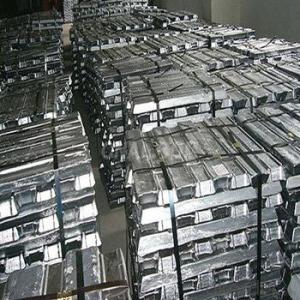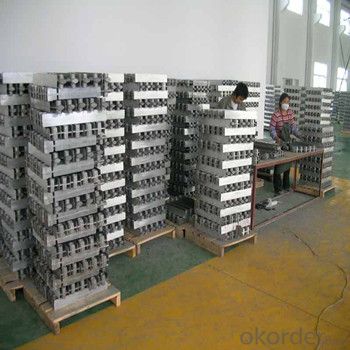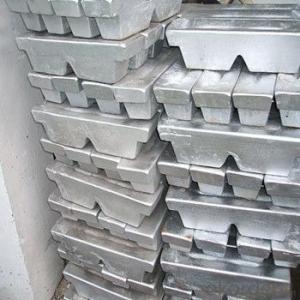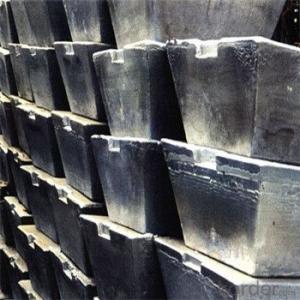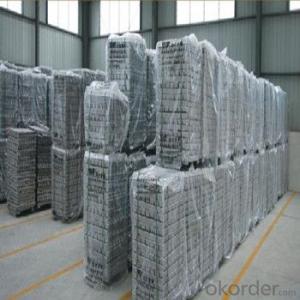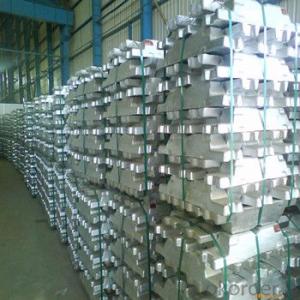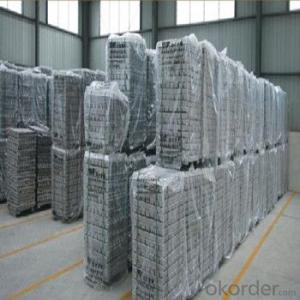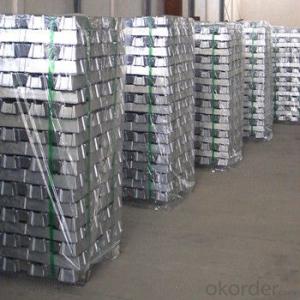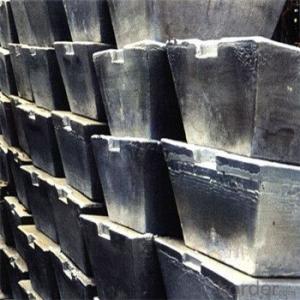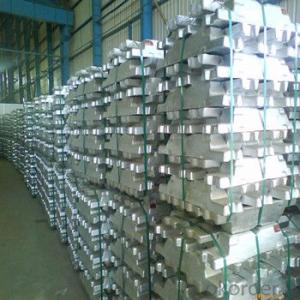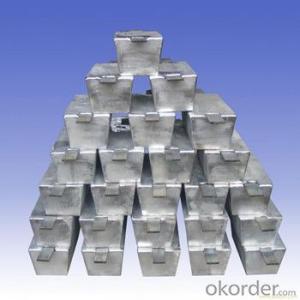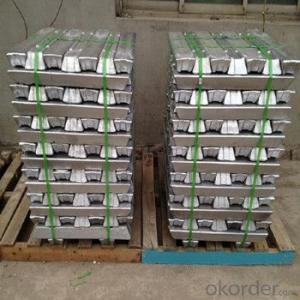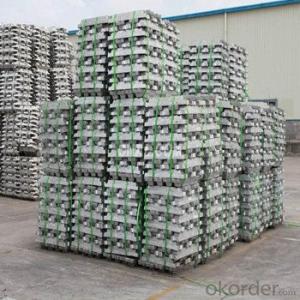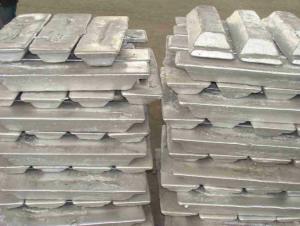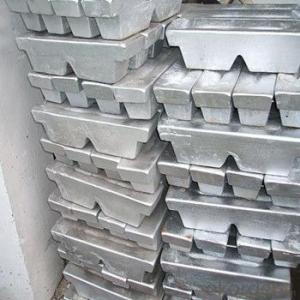Aluminium Ingot with Good Quality and Best Price
- Loading Port:
- China main port
- Payment Terms:
- TT OR LC
- Min Order Qty:
- 1000 m.t.
- Supply Capability:
- 10000 m.t./month
OKorder Service Pledge
OKorder Financial Service
You Might Also Like
Pure Aluminum Ingot Used for Industry
1.Structure of Aluminum Ingot Description
Aluminum Ingot is with the AL as the main chemical composition. Aluminum Ingot is used for industry,such as automobile,pinning and weaving,electron broadly and so on. Aluminum Ingot has the following advantages: easy control and operation, fast melting.
2.Main Features of the Aluminum Ingot
•High Purity
•Easy control and operation
•High strength
•Fast melting
•Competitive price
•Best Service
3. Aluminum Ingot Images


4. Aluminum Ingot Specification
Grade | Chemical Composition % | |||||||||
Al≥ | impurities ≤ | |||||||||
Si | Fe | Cu | Ga | Mg | Zn | Mn | others | Sum | ||
Al99.9 | 99.90 | 0.50 | 0.07 | 0.005 | 0.02 | 0.01 | 0.025 | - | 0.010 | 0.10 |
Al99.85 | 99.85 | 0.80 | 0.12 | 0.005 | 0.03 | 0.02 | 0.030 | - | 0.015 | 0.15 |
Al99.7 | 99.70 | 0.10 | 0.20 | 0.010 | 0.03 | 0.02 | 0.030 | - | 0.030 | 0.30 |
Al99.6 | 99.60 | 0.16 | 0.25 | 0.010 | 0.03 | 0.03 | 0.030 | - | 0.030 | 0.40 |
Al99.5 | 99.50 | 0.22 | 0.30 | 0.020 | 0.03 | 0.05 | 0.050 | - | 0.030 | 0.50 |
Al99.00 | 99.00 | 0.42 | 0.50 | 0.020 | 0.03 | 0.05 | 0.050 | - | 0.050 | 1.00 |
5.FAQ of Aluminum Ingot
We have organized several common questions for our clients,may help you sincerely:
①How about your company?
A world class manufacturer & supplier of castings forging in carbon steel and alloy steel,is one of the large-scale professional investment casting production bases in China,consisting of both casting foundry forging and machining factory. Annually more than 8000 tons Precision casting and forging parts are exported to markets in Europe,America and Japan. OEM casting and forging service available according to customer’s requirements.
②How to guarantee the quality of the products?
We have established the international advanced quality management system,every link from raw material to final product we have strict quality test;We resolutely put an end to unqualified products flowing into the market. At the same time, we will provide necessary follow-up service assurance.
③How long can we receive the product after purchase?
In the purchase of product within three working days, We will arrange the factory delivery as soon as possible. The pecific time of receiving is related to the state and position of customers.Commonly 7 to 10 working days can be served.
- Q: Are aluminum alloy ADC12 and aluminium ingot ADC12 the same?What's the difference? The price you see in Ali looks different
- Friends, you ask what is the same thing, the price is certainly not the same, the aluminum ingot price is floating
- Q: What are the main components of aluminum ingots?
- Aluminum ingots primarily consist of aluminum metal, containing small amounts of impurities. They are produced through the smelting of aluminum ore, typically bauxite, which contains aluminum oxide. The ore undergoes processing to extract the aluminum oxide, which is then refined and melted to create the ingots. These ingots generally contain 99% or more pure aluminum, with the remaining percentage comprising impurities like silicon, iron, copper, magnesium, and other elements. The specific production process and quality of raw materials used may cause variations in the impurity composition. Nonetheless, the high purity of aluminum ingots ensures their suitability for diverse industrial applications, including the manufacturing of various aluminum products.
- Q: What are the different forms of aluminum ingots available in the market?
- There are several different forms of aluminum ingots available in the market, including standard ingots, T-ingots, sow ingots, and rolled ingots.
- Q: How are aluminum ingots inspected for quality?
- Aluminum ingots are inspected for quality through a thorough and systematic process. The inspection typically involves visual examination, dimensional measurements, and various testing methods. Firstly, visual inspection is conducted to identify any surface defects, such as cracks, dents, or impurities. This is performed by trained inspectors who closely examine the ingots to ensure they meet the required standards. Next, dimensional measurements are taken to verify the ingots' size and weight. This involves using precise instruments like calipers or digital measuring devices to check the length, width, height, and weight of each ingot. These measurements are compared against the specified tolerances to ensure compliance. In addition to visual inspection and dimensional measurements, various testing methods are employed to assess the mechanical properties and chemical composition of the aluminum ingots. These tests can include hardness testing, tensile strength testing, impact testing, and spectroscopic analysis. Hardness testing determines the resistance of the ingot to indentation or deformation, providing insights into its strength. Tensile strength testing measures the maximum amount of stress the ingot can withstand before breaking. Impact testing assesses the ingot's ability to absorb energy under sudden loading conditions. These tests help identify any weaknesses or inconsistencies in the ingot's mechanical properties. Furthermore, spectroscopic analysis is used to determine the chemical composition of the ingots. This involves analyzing the elements present in the aluminum alloy and comparing them against the specified composition. It ensures that the desired alloying elements are present in the correct proportions, ensuring the ingots' suitability for specific applications. Overall, the inspection of aluminum ingots for quality involves a combination of visual examination, dimensional measurements, and various testing methods. By following these rigorous quality control procedures, manufacturers can ensure that the aluminum ingots delivered to customers meet the required standards and are of high quality.
- Q: What are the main factors influencing the choice between aluminum ingots and aluminum slabs?
- The choice between aluminum ingots and aluminum slabs can be influenced by several factors. Firstly, the production process plays a crucial role. Ingots are commonly used for casting and shaping purposes due to their easy meltability and moldability. On the other hand, slabs are often utilized in rolling and extrusion processes to create thin sheets or various shapes. Secondly, the specific requirements of the end product can impact the decision. If the final product needs a particular shape or thickness, slabs may be preferred as they can be directly processed into the desired dimensions. However, if the product requires casting into complex shapes, ingots may be more suitable. Moreover, cost considerations also come into play. Ingots are generally cheaper to produce as they require less processing and have fewer quality requirements. Conversely, slabs may involve additional steps like rolling or extrusion, which can increase production costs. Market demand is another essential factor. If there is a higher demand for products derived from slabs, such as sheet metal or extruded profiles, then slabs would be preferred to meet the market needs efficiently. Additionally, the available production capacity and resources of a manufacturer can influence the decision. If a company has the necessary machinery and capabilities to process aluminum slabs efficiently, it may choose slabs over ingots to maximize its production capacity and resources. In conclusion, manufacturers must carefully evaluate the production process, product requirements, cost considerations, market demand, and available resources to make an informed decision regarding the use of aluminum ingots or slabs. By considering these factors, they can align their production capabilities with market demands effectively.
- Q: How are impurities removed from aluminum ingots?
- Impurities are typically removed from aluminum ingots through a process called refining. This involves heating the ingots to a molten state and then introducing various fluxes or chemical agents that react with the impurities, causing them to separate and rise to the surface. The impurities are then skimmed off, leaving behind purified aluminum.
- Q: How are aluminum ingots used in the production of household appliances?
- Aluminum ingots are used in the production of household appliances as they can be easily molded into various shapes and sizes. They are commonly used to make the outer casings and frames of appliances such as refrigerators, ovens, and washing machines due to their lightweight, durable, and corrosion-resistant properties. Additionally, aluminum ingots are also used in the production of heat sinks and electrical components within appliances to dissipate heat efficiently and ensure optimal performance.
- Q: How are aluminum ingots used in the production of solar panels?
- Aluminum ingots play a crucial role in the production of solar panels. These ingots are used primarily in the frame and mounting structures of solar panels. The frame of a solar panel is responsible for providing structural support and protection to the delicate photovoltaic (PV) cells. Aluminum ingots are preferred for constructing the frame due to their exceptional strength-to-weight ratio and corrosion resistance. This ensures that the solar panels can withstand harsh weather conditions and remain durable throughout their lifespan. In addition to the frame, aluminum ingots are also used in the mounting structures of solar panels. The mounting structure is responsible for securely attaching the solar panels to rooftops, ground mounts, or other surfaces. Aluminum ingots are an ideal choice for these structures as they are lightweight, making them easier to handle, transport, and install. Furthermore, aluminum is a highly recyclable material, which makes it an environmentally friendly choice for the production of solar panels. By using aluminum ingots, manufacturers can significantly reduce the carbon footprint associated with the production process. Overall, aluminum ingots are essential in the production of solar panels as they provide structural integrity, corrosion resistance, lightweight properties, and environmental sustainability. Their utilization in the frame and mounting structures enhances the overall performance and longevity of solar panels, contributing to the growth of the renewable energy sector.
- Q: What are the limitations of using aluminum ingots in high-temperature applications?
- There are several limitations associated with using aluminum ingots in high-temperature applications. Firstly, aluminum has a relatively low melting point of around 660 degrees Celsius. This means that it may not be able to withstand extremely high temperatures typically encountered in some industrial processes or aerospace applications. At such elevated temperatures, aluminum tends to soften and lose its mechanical strength, which can compromise the integrity and functionality of the component or structure. Secondly, aluminum has a high coefficient of thermal expansion. This means that it expands significantly when exposed to heat. This expansion can lead to dimensional instability and can cause issues such as warping or distortion of the component, especially when subjected to rapid or uneven heating and cooling cycles. These dimensional changes can affect the accuracy of the final product and may require additional measures to compensate for the thermal expansion. Additionally, aluminum has relatively poor resistance to oxidation at high temperatures. When exposed to oxygen at elevated temperatures, aluminum can form a thin layer of aluminum oxide, which can act as a barrier and protect the underlying metal from further oxidation. However, at extremely high temperatures, this protective layer can break down, leading to increased susceptibility to oxidation and corrosion. This can result in a reduction in the strength and durability of the aluminum component. Lastly, aluminum has a relatively low strength compared to other materials such as steel or titanium. While aluminum alloys can be developed to enhance their strength, they still may not be suitable for applications requiring exceptional strength at high temperatures. In situations where high mechanical strength is crucial, alternative materials with better high-temperature strength properties may be more suitable. In summary, the limitations of using aluminum ingots in high-temperature applications include its low melting point, high coefficient of thermal expansion, susceptibility to oxidation, and relatively low strength. These factors need to be carefully considered when selecting materials for high-temperature applications to ensure the desired performance and reliability of the components or structures.
- Q: What does nonstandard pure aluminium ingot mean?
- That is, parallel ingot, standard aluminum ingot purity of 99.7%, non-standard is below this standard.
Send your message to us
Aluminium Ingot with Good Quality and Best Price
- Loading Port:
- China main port
- Payment Terms:
- TT OR LC
- Min Order Qty:
- 1000 m.t.
- Supply Capability:
- 10000 m.t./month
OKorder Service Pledge
OKorder Financial Service
Similar products
Hot products
Hot Searches
